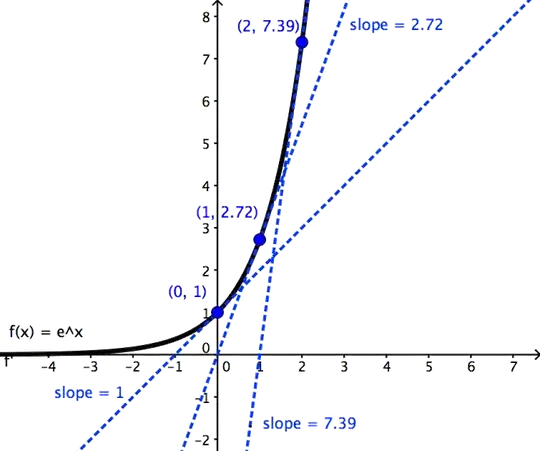$$\frac{d}{dx} e^x=e^x$$ Please explain simply as I haven't studied the first principle of differentiation yet, but I know the basics of differentiation.
-
12how is $e^x$ defined? – sranthrop Dec 24 '14 at 14:39
-
5If you don't have the definition of derivative, how do you know the basics of differentiation? It's hard to know how to answer your question. – Simon S Dec 24 '14 at 14:40
-
1Maybe he wants an intuitive answer, just to grasp the meaning behind this basic result. – Drarp Dec 24 '14 at 14:41
-
2Try this then. Imagine a function $f$ such that $df/dx = f$. What does the graph look like? Try to sketch it out. You'll (hopefully) convince yourself it has to look like an exponential function $f(x) = Ca^x$. To narrow to why $a = e$, we need to do a bit more technical work. – Simon S Dec 24 '14 at 14:43
-
This really needs some editing to improve the question, but I voted to leave it open because it has attracted some good answers which have been well supported by votes, and which do attempt in different ways, to address elementary understandings related to the exponential function and its derivative. – Mark Bennet Dec 25 '14 at 01:12
9 Answers
Have a look at the series representation of $e^x$ which is $$e^x=\sum_{n=0}^{\infty}\frac{x^n}{n!}=1+x+\frac{x^2}{2}+\frac{x^3}{6}+\frac{x^4}{24}+\frac{x^5}{120}+\dots$$ Taking derivative of this gives $$\left(e^x\right)'=\left(\sum_{n=0}^{\infty}\frac{x^n}{n!}\right)'=\left(1+x+\frac{x^2}{2}+\frac{x^3}{6}+\frac{x^4}{24}+\frac{x^5}{120}+\dots\right)'$$ $$=1'+x'+\left(\frac{x^2}{2}\right)'+\left(\frac{x^3}{6}\right)'+\left(\frac{x^4}{24}\right)'+\left(\frac{x^5}{120}\right)'+\dots$$ $$\implies (e^x)'=\sum_{n=0}^{\infty}\left(\frac{x^n}{n!}\right)'$$Then, differentiating term by term gives us $$(e^x)'=0+1+x+\frac{x^2}{2}+\frac{x^3}{6}+\frac{x^4}{24}+\dots$$ $$=1+x+\frac{x^2}{2}+\frac{x^3}{6}+\frac{x^4}{24}+\frac{x^5}{120}+\dots$$ $$=e^x$$ $$\implies \frac{d}{dx}e^x=e^x$$
- 3,678
-
5You have to justify the interchange of limit operations here. A priori, it is not clear at all that $\frac{\mathrm d}{\mathrm dx}\left(\lim_{n\to\infty}\sum_{k=0}^n\frac{x^k}{k!}\right)$ is equal to $\lim_{n\to\infty}\left(\sum_{k=0}^n\frac{\mathrm d}{\mathrm dx}\left(\frac{x^k}{k!}\right)\right)$. – Math1000 Dec 24 '14 at 15:00
-
3@Math1000: I agree that it should be mentioned for completeness that any power series can be differentiated (or integrated) term by term in the interior of the domain of convergence. See for example: http://math.stackexchange.com/questions/484250/is-there-a-simple-proof-that-a-power-series-can-be-differentiated-term-by-term – Dec 25 '14 at 00:44
\begin{align} \frac{d}{dx}e^x &= \frac{d}{dx}\left(1+\frac{x}{1!}+\frac{x^2}{2!}+\frac{x^3}{3!}+\dots \right)\\ &=0+\frac{1}{1!}+\frac{2x}{2!}+\frac{3x^2}{3!}+\dots\\ &=0+1+\frac{x}{1!}+\frac{x^2}{2!}+\frac{x^3}{3!}+\dots\\ &=0 + e^x\\ &=e^x \end{align}
- 5,011
$$e^x=\lim_{n\to\infty}\left(1+\frac{x}{n} \right)^n$$
\begin{align} \frac{d}{dx}e^x &= \frac{d}{dx}\lim_{n\to\infty}\left(1+\frac{x}{n} \right)^n\\ &=\lim_{n\to\infty}\frac{d}{dx}\left(1+\frac{x}{n} \right)^n\\ &=\lim_{n\to\infty}n\left(1+\frac{x}{n} \right)^{n-1}\cdot\frac{1}{n}\\ &=\lim_{n\to\infty}\left(1+\frac{x}{n} \right)^{n-1}\\ &=\lim_{n\to\infty}\left(1+\frac{x}{n} \right)^{-1}\cdot\lim_{n\to\infty}\left(1+\frac{x}{n} \right)^n\\ &=1\cdot e^x\\ &=e^x \end{align}
- 5,011
-
3I think you need to justifying switching the limit and the differentiation. – Potato Mar 23 '15 at 09:17
$$\frac{d}{dx}e^x=\lim_{h\to 0}\frac{e^{x+h}-e^x}{h}=\lim_{h\to 0}e^x\left(\frac{e^h-1}{h}\right)=e^x\lim_{h\to 0}\frac{e^h-1}{h}=e^x\lim_{h\to 0}\frac{1+h-1+o(h)}{h}$$$$=e^x\lim_{h\to 0}\left(1+\underbrace{\frac{o(h)}{h}}_{\to 0}\right)=e^x$$
- 11,824
-
4This answer is logically circular. The only way you get the power series approximation for $e^h$ is to know the derivative. – Simon S Dec 24 '14 at 14:57
-
3
-
Visual Representation of the Slope of $e^x$

We can see that the slope is equal to $y$ at any point $(x, y)$.
Proof by Implicit Differentiation
First note that $$ \frac{d}{dx}\ln x=\frac{1}{x} $$ And $$ \frac{d}{dx}f(g(x))=\frac{d}{dg(x)}f(g(x))\frac{d}{dx}g(x) $$ So now we have $$ f(x)=e^x $$ $$ \ln f(x)=\ln e^x $$ $$ \ln f(x)=x $$ $$ \frac{d}{dx}\ln f(x)=\frac{d}{dx}x $$ $$ \frac{1}{f(x)}\left(\frac{d}{dx}f(x)\right)=1 $$ $$ \frac{d}{dx}f(x)=f(x)$$ $$ \frac{d}{dx}e^x=e^x$$
solving the equation $\frac{df}{dx}=f$ we get $$\frac{df}{f}=dx$$ and we obtain $$\ln|f|=x+C$$ from here we get $$f(x)=e^{x+C}$$ with $f(0)=1$ we get $$f(x)=e^x$$
- 11,595
- 95,283
-
3Nice. I would also finally add that the boundary condition is $f(0)=0,$ otherwise $e^x$ is not uniquely defined! – beep-boop Dec 24 '14 at 15:03
-
@alexqwx I think you mean $f(0)=1$. Of course, any function in the form $f(x)=Ae^x$ is equal to it's derivative, $e^x$ is just a canonical example. – orion Dec 24 '14 at 15:50
-
-
3Note that $\ln|f(x)|=x+C$ does NOT yield $f(x)=e^{x+C}$ but $f(x)=\pm e^{x+C}$. – Did Dec 27 '14 at 00:23
-
10
-
This proves that if there is a solution to f’=f then it must look like Ce^x, but leaves open the question of whether or not a solution exists. – subrosar Apr 20 '21 at 04:00
Let $y = e^x$:
$$\begin{align*} x &= \ln y\\ \frac{dx}{dy} &= \lim_{h\to0}\frac{\ln(y+h)-\ln y}{h}\\ &=\lim_{h\to0}\ln\left(1+\frac{h}{y}\right)^\frac1h\\ &=\ln\lim_{h\to0}\left(1+\frac{h}{y}\right)^{\frac yh\cdot \frac1y}\\ &= \ln \left(e^\frac1y\right)\\ &= \frac1y\\ &= \frac1{e^x}\\ \frac{dy}{dx} &= e^x \end{align*}$$
- 22,256
-
1This is the only attempt that's not a circular reasoning yet it is unrecognized by most posters here! I am baffled! – Aug 23 '20 at 15:37
The number $e$ is defined by: $e=\sum\limits_{n=0}^\infty\dfrac{1}{n!}$ but historically I think that the definition of the $exp$ function is: $e^x=\lim\limits_{n\to+\infty}\left(1+\dfrac{x}{n}\right)^n$ and the properties of this function comes from this definition as shown in this article.
- 8,781
-
Not correct. Historically, $e^x$ was defined at first as infinite power series. Limits come only in the second half of XIXc. – user48672 Mar 23 '15 at 00:56
-
@user48672 I just edited the link to the article. You can now have access to it. Also, see this:
http://www-history.mcs.st-andrews.ac.uk/HistTopics/e.html
In the 6th paragraph, we see that the limit concept was already present in 1683. The definition $e=\sum_{n=0}^\infty\frac{1}{n!}$ comes in 1748.
– Scientifica Mar 23 '15 at 08:53
Here is the computation of the derivative of the general $y= a^x$ where a can be any positive number. $y(x+ h)- y(x)= a^{x+ h}- a^x= (a^x)(a^h)- a^x= a^x(a^h- 1)$ So $\frac{y(x+h)- y(x)}{h}= a^x\left(\frac{a^h- 1}{h}\right)$
$\frac{da^x}{dx}= \lim_{h\to 0}a^x\left(\frac{a^h- 1}{h}\right)$ $= a^x\lim_{h\to 0}\left(\frac{a^h- 1}{h}\right)$
So the derivative of $a^x$ is $a^x$ times some constant, $\lim_{h\to 0}\frac{a^h- 1}{h}$.
It is easy to see that, if a= 1, since $a^h= 1$ for all x, that limit is 0 and if a= 3, since $3^{0.001}= 1.001099$, approximately, $\frac{1.01099- 1}{0.001}= 1.099$, there is some a, between 1 and 3, such that $\ lim_{h\to 0} \frac{a^{x+h}- a^x}{h}= 1$.
We define "e" to be that value of a so that the derivative of $e^x$ is 1 times $e^x$.
- 18,710